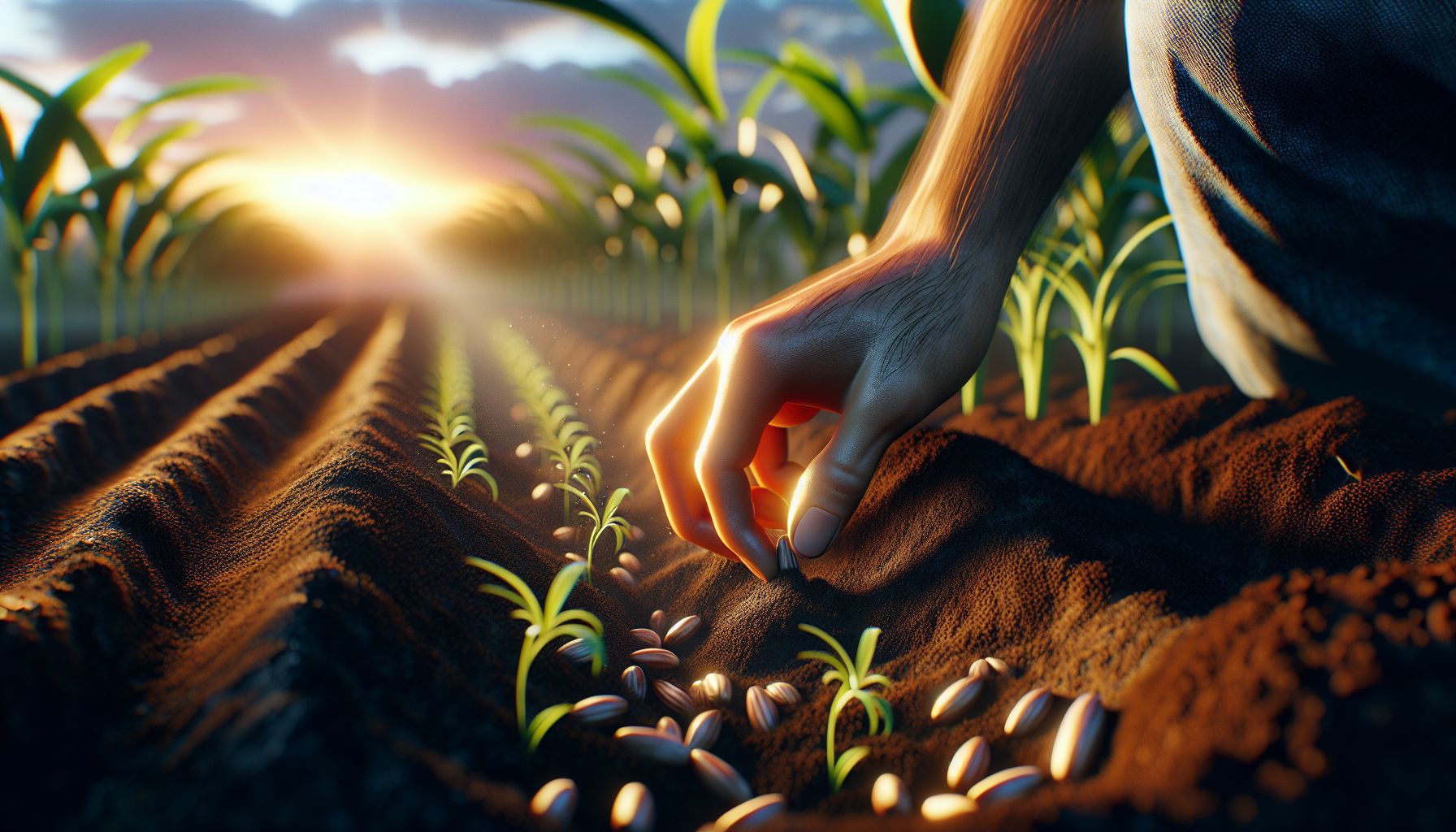In the quiet choreography of nature, seeds perform an extraordinary dance beneath the soil, a dance that has sustained life on Earth for millennia. This dance is not merely a random scattering but a meticulously orchestrated act of survival and renewal. As we stand on the precipice of agricultural innovation, it’s time to delve into one of nature’s most profound mysteries: seed-burying. What if this simple, yet intricate process could be harnessed to revolutionize how we cultivate our food? 🌱
Unlocking the power of seed-burying opens a gateway to a more sustainable and bountiful future. This practice, deeply rooted in both ancient traditions and modern science, holds the key to addressing some of today’s most pressing agricultural challenges. As our global population continues to swell, the demand for efficient and productive farming techniques is more critical than ever. Seed-burying, when done with intentionality and understanding, can significantly boost crop yields, enhance soil health, and promote biodiversity. But how exactly does this process work, and what can we learn from nature’s own methods to improve our agricultural systems?
In this exploration, we’ll journey through the fascinating world of seed-burying, starting with its natural occurrence in ecosystems around the globe. From the industrious squirrels that inadvertently sow oak forests to the ancient farming practices of indigenous peoples who understood the magic of seed placement, we’ll uncover how different species and cultures have long benefited from this natural phenomenon. Our modern perspective often overlooks these age-old insights, but revisiting them with a scientific lens reveals their invaluable contributions to sustainable agriculture.
Next, we’ll delve into the scientific principles that underpin intentional seed-burying. We’ll examine the latest research that highlights how this method can improve germination rates and plant resilience. By understanding the optimal conditions for seed depth, soil composition, and moisture levels, farmers and gardeners can maximize the potential of each seed planted. Moreover, we’ll discuss how these practices can be tailored to various environmental conditions, offering adaptable solutions for diverse climates and soil types.
Finally, we’ll address the future implications of harnessing intentional seed-burying. In an era where climate change poses unprecedented challenges, adopting techniques that enhance ecosystem resilience is not just beneficial but necessary. By integrating traditional knowledge with cutting-edge science, we can foster agricultural practices that not only feed the world but also heal the planet. Through thoughtful seed-burying, we have the opportunity to cultivate abundance while nurturing the Earth’s delicate balance. This article will equip you with the insights and practical knowledge needed to embark on this transformative journey. 🌾
Prepare to unlock the potential hidden beneath the soil and discover how intentional planting can lead to bountiful harvests that sustain both people and the planet.
The Art and Science of Seed-Burying
The concept of seed-burying has been integral to agriculture for millennia, serving as a fundamental technique to ensure robust plant growth and yield. Seed-burying, when executed with precision, allows seeds to be planted at an optimal depth, ensuring they have the best chance to germinate, receive adequate nutrients, and develop into healthy plants. This practice leverages the natural environment to maximize agricultural productivity while minimizing resource input, offering an eco-friendly approach to farming that is both sustainable and effective. By understanding the variables that impact seed-burying, such as soil composition, seed type, and environmental conditions, farmers can unlock the full potential of their crops, ensuring bountiful harvests year after year.
The importance of depth in seed-burying cannot be overstated. Planting seeds at the correct depth is crucial for their survival and growth. If seeds are buried too shallow, they may be exposed to environmental stressors such as wind and water erosion. Conversely, seeds buried too deep may struggle to break through the soil surface. This balance is vital in optimizing germination rates. For instance, a study on maize crops demonstrated that seeds planted at a depth of 5 cm had a 20% higher germination rate compared to those planted at 10 cm, highlighting the significance of precise planting techniques. This is why modern agriculture often employs machinery calibrated to ensure seeds are buried at the optimal depth, reducing human error and improving overall efficiency.
Beyond depth, the choice of soil also plays a crucial role in seed-burying. Different soil types, such as clay, loam, or sand, have varying water retention capabilities, nutrient availability, and aeration properties, all of which affect seed development. Clay soil, for example, retains water effectively but can become compacted, which may hinder seedling emergence. In contrast, sandy soil offers excellent drainage but may require more frequent watering to prevent dehydration. Loam, often considered the ideal soil type, strikes a balance with good water retention and aeration. To make informed decisions, farmers often analyze soil samples before planting, allowing them to amend the soil with organic matter or fertilizers to optimize conditions for seed germination and growth.
Harnessing Intentional Planting Techniques
Intentional planting is an approach that goes beyond the mere act of placing seeds in the ground. It involves strategic planning and execution to ensure that every element of the planting process is aligned with the goal of achieving maximum yield. One key aspect of intentional planting is crop rotation, which involves changing the type of crops grown in a particular area from season to season. This practice helps to manage soil fertility and reduce pest and disease pressure, as different crops have varying nutrient requirements and pest susceptibility. For example, rotating legumes with cereals can naturally enrich the soil with nitrogen, reducing the need for synthetic fertilizers.
Companion planting is another technique that enhances the benefits of intentional planting. This practice involves growing different plant species in proximity to each other to enhance growth, deter pests, and increase crop productivity. For instance, planting basil alongside tomatoes can improve tomato flavor and repel harmful insects. Similarly, marigolds are known to repel nematodes and can be planted around vegetable gardens to protect against these pests. By understanding the symbiotic relationships between different plant species, farmers can create a balanced ecosystem that supports healthy crop growth and reduces dependency on chemical inputs.
Moreover, intentional planting incorporates modern technology to optimize planting schedules and monitor plant health. Advances in agricultural technology, such as GPS-guided equipment and drones, have revolutionized how farmers approach planting. These technologies allow for precise seed placement and real-time monitoring of crop conditions, enabling farmers to make data-driven decisions. For instance, drones equipped with multispectral sensors can assess crop health by analyzing leaf reflectance, allowing farmers to identify areas of stress or disease early and take corrective action promptly. This proactive approach to plant management not only increases yields but also promotes sustainable farming practices.
Technology in Seed-Burying
The integration of technology in seed-burying has transformed traditional agricultural practices, making them more efficient and productive. Automated seed drills, equipped with sensors and GPS technology, can plant seeds at precise depths and spacing, ensuring optimal germination conditions. These machines are designed to adapt to varying field conditions, such as changes in soil type or moisture levels, providing consistent planting results across different environments. Furthermore, these technologies reduce labor costs and minimize human error, allowing farmers to focus on other critical aspects of crop management.
Precision agriculture tools, such as variable rate technology (VRT), enable farmers to apply seeds, water, and fertilizers at variable rates across a field, based on specific soil and crop needs. VRT systems use data from soil tests, satellite imagery, and weather forecasts to create detailed maps that guide the application of inputs. This targeted approach not only maximizes resource use efficiency but also reduces environmental impact by minimizing the over-application of chemicals and water.
To further illustrate the impact of technology on seed-burying, watch this insightful video titled “How Precision Agriculture is Changing the World” by the channel Tech Insider: Watch Video. This video provides a comprehensive overview of how technological advancements are shaping modern agriculture, highlighting real-world examples of successful implementations.
Practical Steps for Successful Seed-Burying
Implementing successful seed-burying techniques requires careful planning and execution. The first step is to select the appropriate seed varieties that are well-suited to the specific growing conditions of the region. Factors such as climate, soil type, and market demand should guide the selection process. For example, drought-resistant seed varieties may be ideal for regions with limited rainfall, while disease-resistant varieties can reduce the need for chemical interventions in areas prone to specific plant diseases.
Once the seed selection is made, preparing the soil is the next crucial step. Soil preparation involves tilling, leveling, and amending the soil to create an ideal environment for seed germination and growth. This may include adding organic matter to improve soil structure, adjusting pH levels, and incorporating fertilizers to supply essential nutrients. Farmers should conduct soil tests to determine the specific needs of their fields, allowing them to make informed decisions about soil amendments.
The actual process of seed-burying should be conducted with precision, using either traditional methods or modern machinery, depending on the scale of the operation. Small-scale farmers may opt for manual planting techniques, while large-scale operations benefit from mechanized planting equipment. Regardless of the method, the key is to ensure seeds are planted at the correct depth and spacing to maximize germination and growth. Properly calibrated equipment and careful attention to planting conditions can significantly enhance the success rate of seed-burying efforts.
Comparative Analysis of Seed-Burying Techniques
To better understand the effectiveness of different seed-burying techniques, consider the following comparative analysis. This table compares traditional manual planting with modern mechanized planting methods, highlighting key differences in efficiency, cost, and scalability.
| Criteria | Manual Planting | Mechanized Planting |
|---|---|---|
| Efficiency | Labor-intensive, time-consuming | High efficiency, rapid planting |
| Cost | Lower initial cost, higher labor costs | Higher initial investment, lower labor costs |
| Scalability | Limited by labor availability | Easily scalable for large operations |
| Precision | Variable, dependent on skill | High precision, consistent results |
By analyzing this table, farmers can make informed decisions about which seed-burying technique best suits their needs and resources. Whether opting for manual or mechanized methods, the goal remains the same: to optimize seed placement for maximum yield potential.
Challenges and Opportunities in Seed-Burying
Despite the advancements in seed-burying techniques, several challenges remain that can impact their effectiveness. One significant challenge is the unpredictability of weather patterns due to climate change. Extreme weather events, such as droughts or heavy rains, can disrupt planting schedules and affect seed germination rates. Farmers must adapt to these changes by implementing resilient agricultural practices, such as using drought-tolerant seed varieties or adopting water conservation techniques like drip irrigation.
Pest and disease pressure also pose challenges to successful seed-burying. While intentional planting techniques like crop rotation and companion planting can mitigate some of these issues, the threat of new pests and diseases remains a concern. Integrated pest management (IPM) strategies, which combine biological, cultural, and chemical control methods, can help manage pest populations and reduce their impact on crop yields. Additionally, ongoing research and development of disease-resistant seed varieties offer promising solutions to combat emerging threats.
On the other hand, the challenges of seed-burying present opportunities for innovation and growth. The increasing demand for sustainable and eco-friendly agricultural practices has led to the development of new technologies and techniques that enhance seed-burying efficiency. For example, the use of biodegradable seed tapes, which contain seeds pre-spaced and embedded in a biodegradable material, offers a convenient and environmentally friendly planting option. As consumer awareness of sustainability grows, farmers who adopt these practices can gain a competitive edge in the market.
Emerging Trends in Seed-Burying
The future of seed-burying is being shaped by emerging trends that promise to revolutionize agriculture. One such trend is the integration of artificial intelligence (AI) and machine learning in farming practices. AI-powered tools can analyze vast amounts of data to provide actionable insights for optimizing seed-burying techniques. These tools can predict optimal planting times, assess soil health, and even forecast potential pest outbreaks, allowing farmers to make data-driven decisions.
Another trend is the growing interest in regenerative agriculture, which focuses on restoring soil health and biodiversity through practices like cover cropping and no-till farming. These practices complement seed-burying techniques by enhancing soil structure and fertility, creating a more resilient and productive agricultural system. As farmers increasingly adopt regenerative practices, they contribute to the long-term sustainability and health of their land, ensuring continued productivity for future generations.
To stay informed about the latest advancements in seed-burying and agriculture, consider subscribing to channels and resources that provide up-to-date information on industry trends. Engaging with a community of like-minded individuals can inspire new ideas and foster collaboration, driving innovation and progress in the field.

Conclusion
In conclusion, the practice of intentional seed-burying presents a profound opportunity to revolutionize agricultural practices and enhance food security globally. Throughout this article, we’ve explored the intricate relationship between strategic planting and successful harvests, highlighting the nuances of soil conditions, seed selection, and timing. By understanding and implementing these principles, farmers and gardeners alike can maximize their yields and contribute to a more sustainable future.
One of the key points we examined is the importance of soil quality. Healthy, nutrient-rich soil is foundational to any thriving plant ecosystem. It is crucial for farmers to regularly test and amend their soil to ensure it meets the necessary requirements for their specific crops. The role of organic matter, proper pH balance, and adequate drainage were also emphasized as critical components of fertile ground.
Furthermore, the article delved into the significance of seed selection and its impact on crop yield. Choosing the right seeds means taking into consideration factors such as climate compatibility, resistance to pests and diseases, and potential for high yield. Modern advancements in seed technology offer a myriad of options, allowing for customization and optimization of planting strategies.
Timing is another essential factor we discussed. Understanding the life cycle of plants and their specific needs during different growth stages can significantly influence the outcome of a harvest. This includes planting at optimal times, recognizing the appropriate depth for seed-burying, and monitoring environmental conditions such as temperature and moisture levels.
Moreover, the role of biodiversity in farming practices cannot be overlooked. By integrating diverse plant species and implementing crop rotation, farmers can enhance soil health, reduce pest populations, and increase resilience against climate change. This holistic approach not only benefits the individual farm but also contributes to the overall health of the ecosystem.
As we navigate the challenges of climate change and a growing global population, adopting intentional seed-burying practices becomes even more vital. It empowers communities to become more self-sufficient and less reliant on chemical interventions, leading to healthier food production systems. This not only supports local economies but also promotes environmental conservation and biodiversity.
The potential benefits of intentional seed-burying are vast, yet the success of these practices relies heavily on education and community involvement. By sharing knowledge and resources, individuals and communities can collaborate to implement effective planting strategies that cater to their specific environmental conditions.
We invite you to reflect on the insights shared in this article and consider how they can be applied within your own gardening or farming endeavors. Whether you are a seasoned farmer or a novice gardener, there is always room for growth and innovation. Engage with your local agricultural community, participate in workshops, or seek guidance from experts to enhance your understanding and skills.
In the spirit of collaboration and continuous learning, we encourage you to share your experiences, challenges, and successes with intentional seed-burying. Your insights can inspire others and contribute to a collective effort towards more sustainable and productive agricultural practices. 🌱
Finally, let’s keep this conversation alive! Share this article with friends, colleagues, and fellow enthusiasts who are passionate about agriculture and sustainability. Together, we can cultivate a future where food security and environmental stewardship go hand in hand.
For further reading and to delve deeper into the science and techniques of intentional seed-burying, consider exploring these resources:
–
– International Seed Testing Association
– Rodale Institute on Organic Farming
Thank you for joining us on this journey to unlock the power of seed-burying. Let’s plant the seeds of change and nurture a world where bountiful harvests are within reach for all. 🌾
Toni Santos is a visual storyteller and symbolic naturalist whose creations explore the hidden ecologies and forgotten bonds between humans and nature, as whispered through ancient lore. Through an intuitive and myth-sensitive lens, Toni reveals the sacred choreography between flora, fauna, and human spirit — a world where trees once spoke, rivers remembered, and every herb carried a secret name.
His journey is rooted in the esoteric — in the rituals of forest-dwellers, the botanical codes of shamans, and the unspoken pacts that shaped how ancient peoples lived in deep, reciprocal harmony with the natural world. From sacred groves to serpent-guarded springs, each of Toni’s works reflects a symbolic relationship long obscured by modern forgetfulness.
With a background in visual design and ancestral aesthetics, Toni merges storytelling with sacred ecology. His pieces don’t simply illustrate — they channel. Drawing from myth, mysticism, and lost herbal traditions, he crafts visuals that resonate with the old wisdom: that nature is not background, but kin.
As the creative spirit behind Vizovex, Toni shares collections, visual studies, and articles that illuminate the occulted connections between human life and the wild world. His work calls on us to remember — not just with the mind, but with the senses and the soul — the profound dialogues our ancestors once had with earth, plant, and animal.
His work is a tribute to:
The mythic language of trees, stones, and roots
Forgotten pacts between healers and the wilderness
The sacred knowledge carried in nature’s unseen patterns
Whether you’re a seeker of ancient plant-lore, a mystic attuned to seasonal cycles, or simply someone who hears the forest speak, Toni welcomes you to wander a space where symbolism, nature, and spirit entwine — one myth, one leaf, one vision at a time.





